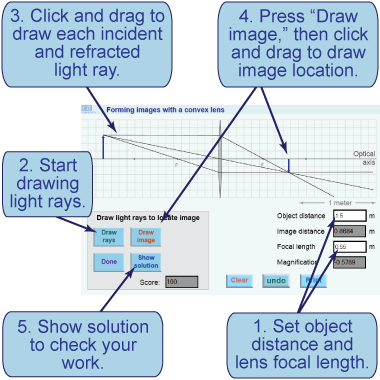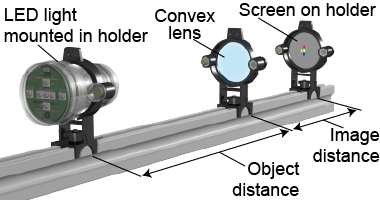|
| Essential questions | | How does a convex lens form an image?
How do you measure the focal length of a lens? | |
|
Light travels in straight lines unless its path is diverted by an optical device—such as a mirror or lens. A convex lens is used in cameras and refracting telescopes to redirect light rays in order to focus light and form an image. In this investigation, you will use an interactive simulation and an actual lens to explore the physics behind image formation by a convex lens. 
|
Part 1: Use ray tracing to locate images

- Enter a focal length of 20 cm and an object distance of 60 cm.
- Press [Draw rays].
- Click and drag the mouse to draw each incident and refracted ray.
- Press [Draw image]. Click and drag the mouse to draw the image at the location where the refracted rays intersect.
- Record the image distance obtained from the simulation and print out a copy to compare your solution with the simulation’s solution. Describe the image properties (upright or inverted, real or virtual, and magnified or reduced in size).
- Repeat for object distances of 40, 20, and 8 cm. Tabulate your results.
- What type of image is produced when the object distance is greater than the focal length? Equal to the focal length? Less than the focal length?

|
|
In this interactive simulation, you will draw light rays to locate the image formed by a convex lens. Set up the simulation by entering the object distance and the focal length of the lens. Then draw light rays through the lens by following the three ray tracing rules. The image is formed where all three light rays intersect. Show the solution to compare with your result. Can you get all three light rays to intersect at a point?
|
Part 2: Test the predicted image locations

- Set up the optical bench as shown. Place the LED light source (the “object”) at an object distance of 60 cm from a convex lens with a 20 cm focal length.
- Slide the screen along the optical bench on the far side of the lens until the sharpest possible image is projected onto the screen.
- Measure the image distance and compare it to your prediction.
- Repeat for object distances of 40 and 20 cm.
- Do your actual measured image distances match your predictions?
- What will the image distance be if you place the LED light source far away (such as at a distance of several meters)? Check your prediction by making the measurement.
- Why can’t you use an object distance of 10 cm with this technique?

|

